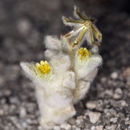pt-BR
nomes no trilho de navegação


Eatonella is a North American genus of plants in the family Asteraceae containing the single known species Eatonella nivea, which is called by the common name white false tickhead. This small annual is native to the western United States, particularly the Great Basin, where it grows in sandy soils. It has been found in Washington (Grant + Kittitas Counties), Oregon, Idaho, Nevada, and eastern California (Modoc, Lassen, Mono, and Inyo Counties).
Eatonella nivea is a short annual plant, growing in a clump rarely more than 5 centimeters (2 inches) high and not much more wide. It has tiny dark green leaves no more than 30 mm (1.2 inches) long, densely packed together and covered in a thick grayish wool. The plant produces flower heads one at a time, which look like tiny pale yellow daisies less than a centimeter across, with up to 13 yellow or purple ray florets and up to 14 yellow disc florets. The fruits are shiny black achenes with white fringe, each a few millimeters long.[2]
The genus was named for the American botanist Daniel Cady Eaton, 1834–1885.[2][3]
Eatonella is a North American genus of plants in the family Asteraceae containing the single known species Eatonella nivea, which is called by the common name white false tickhead. This small annual is native to the western United States, particularly the Great Basin, where it grows in sandy soils. It has been found in Washington (Grant + Kittitas Counties), Oregon, Idaho, Nevada, and eastern California (Modoc, Lassen, Mono, and Inyo Counties).
Eatonella nivea is a short annual plant, growing in a clump rarely more than 5 centimeters (2 inches) high and not much more wide. It has tiny dark green leaves no more than 30 mm (1.2 inches) long, densely packed together and covered in a thick grayish wool. The plant produces flower heads one at a time, which look like tiny pale yellow daisies less than a centimeter across, with up to 13 yellow or purple ray florets and up to 14 yellow disc florets. The fruits are shiny black achenes with white fringe, each a few millimeters long.
The genus was named for the American botanist Daniel Cady Eaton, 1834–1885.
formerly included Eatonella congdonii A.Gray, now called Monolopia congdonii (A.Gray) B.G.BaldwinEatonella es un género de plantas con flores de la familia de las asteráceas. Incluye una sola especie: Eatonella nivea.[1] Es originaria del oeste de Estados Unidos, en particular la Gran Cuenca, donde crece en suelos arenosos.
Es una planta anual rastrera, que forma un grupo no más de cuatro centímetros de alto y no mucho más amplia. Tiene hojas de color verde oscuro pequeñas y cubiertas de una lana de color gris espesa. Lleva flores ordenadas y singulares que se asemejan a pequeñas margaritas de color amarillo pálido a menos de un centímetro de diámetro. A veces se seca con un color púrpura o magenta. Los frutos son aquenios de color negro brillante con franja blanca, cada uno de unos pocos milímetros de largo.
Eatonella nivea fue descrita por (D.C.Eaton) A.Gray y publicado en Proceedings of the American Academy of Arts and Sciences 19: 19. 1883.[2]
Eatonella: nombre genérico que fue otorgado en honor de Daniel Cady Eaton (1834 - 1895), botánico estadounidense.[3]
Eatonella es un género de plantas con flores de la familia de las asteráceas. Incluye una sola especie: Eatonella nivea. Es originaria del oeste de Estados Unidos, en particular la Gran Cuenca, donde crece en suelos arenosos.
Eatonella nivea (D.C.Eaton) A.Gray è una pianta della famiglia delle Asteraceae, endemica degli Stati Uniti occidentali. È l'unica specie del genere Eatonella.
Il genere Eatonella, in passato attribuito alla sottotribù Baeriinae (Heliantheae)[1], è stato recentemente assegnato, sulla base di evidenze filogenetiche derivanti da analisi del DNA ribosomiale, al raggruppamento delle Hulseinae (Madieae)[2].
Eatonella nivea (D.C.Eaton) A.Gray è una pianta della famiglia delle Asteraceae, endemica degli Stati Uniti occidentali. È l'unica specie del genere Eatonella.
Eatonella nivea là một loài thực vật có hoa trong họ Cúc. Loài này được (D.C.Eaton) A.Gray mô tả khoa học đầu tiên năm 1883.[1]
Eatonella nivea là một loài thực vật có hoa trong họ Cúc. Loài này được (D.C.Eaton) A.Gray mô tả khoa học đầu tiên năm 1883.